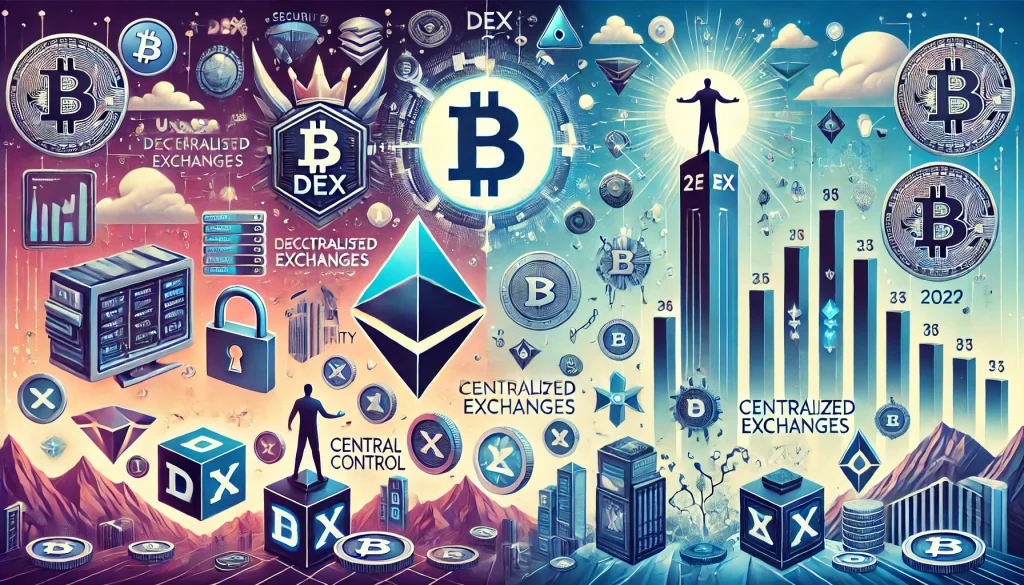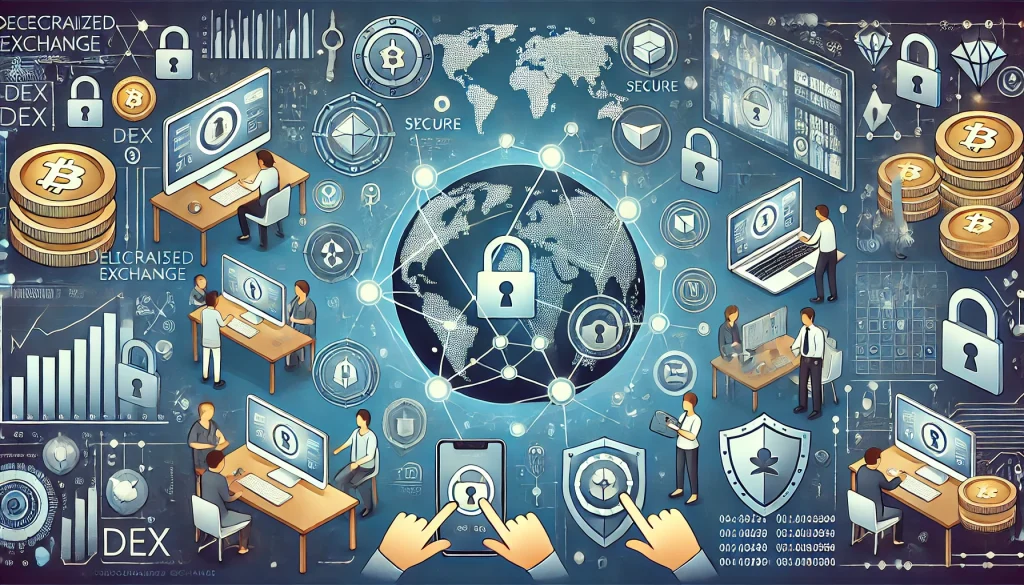
Overview
Decentralized exchanges (DEXs) have emerged as a significant force in cryptocurrency trading in recent years. These platforms offer a distinct alternative to traditional centralized exchanges by leveraging blockchain technology to enable peer-to-peer trading without intermediaries. As a result, DEXs are changing the game of cryptocurrency trading by giving users greater security, privacy, and control over their assets.
DEXs automate transactions through smart contracts and store transaction records on the blockchain to ensure transparency and reliability. This greatly reduces security issues such as hacking and fraud. Users also have direct control over their assets, avoiding the risk of asset freezes or losses that can occur on centralized exchanges.
However, DEXs are not without their challenges. For example, they still have some disadvantages compared to centralized exchanges in terms of trading speed and liquidity. Also, the user interface and experience can be less intuitive, which can be a bit daunting for beginners.
This blog post explores the key aspects of these DEXs, their benefits, challenges, and potential impact on the future of financial markets. The development of DEXs is opening up a new chapter in cryptocurrency trading, which has the potential to change the paradigm of the global financial system.
The rise of decentralized exchanges
Decentralized exchanges have become popular for a number of reasons:
- Improved security: Unlike centralized exchanges, DEXs don’t hold users’ funds, which reduces the risk of large-scale hacks.
- User control: Traders have full control over their private keys and funds without having to trust a third party.
- Privacy: On a DEX, transactions can be more private because you don’t have to go through extensive KYC procedures.
- Global accessibility: Anyone with an internet connection can access the DEX, promoting financial inclusion.
Some of the most popular decentralized exchanges include Uniswap, SushiSwap, and PancakeSwap. These platforms utilize automated market makers (AMMs) and liquidity pools to facilitate trades.
Key characteristics of decentralized exchanges
Automated market makers (AMMs):
- DEXs like Uniswap use AMMs, which allow you to trade against a pool of liquidity instead of an order book.
- AMMs use algorithms to provide continuous liquidity and fair prices.
Liquidity pools:
- Users can deposit assets into pools to provide liquidity to the exchange and earn fees in return.
- This system allows anyone to participate in market making and earn rewards.
Token swap:
- DEXs support seamless token swaps, allowing users to exchange one cryptocurrency for another directly.
- This process is faster and more cost-effective than using a centralized exchange.
A comparative analysis of DEXs and CEXs

The following table highlights the key differences between decentralized exchanges (DEXs) and centralized exchanges (CEXs):
| Features | Decentralized exchanges (DEXs) | Centralized Exchange (CEX) |
|---|---|---|
| Control | Full user control | Exchange holds user funds |
| Security | Low risk of hacking | High risk of hacking due to centralization |
| Privacy | High | Low, extensive KYC required |
| Liquidity | User-provided | Provided by the exchange |
| Regulation | Less regulated | Highly regulated |
| Accessibility | Anyone in the world | Restricted in some regions |
Challenges facing decentralized exchanges
Despite their many advantages, DEXs have some challenges that need to be addressed to achieve widespread adoption:
- Scalability: Current blockchain technology limits the scalability of DEXs, which can result in slower transaction speeds and higher fees at peak times.
- User experience: The user interface and experience of many DEXs is not yet as intuitive or polished as centralized exchanges, which can deter new users.
- Regulatory uncertainty: The regulatory landscape for DEXs is still evolving, and there is potential for increased regulation and compliance demands.
- Liquidity issues: AMMs and liquidity pools provide a solution, but for less popular tokens, low liquidity can still be an issue, leading to slippage and price volatility.
Troubleshooting scalability issues
Due to the limitations of current blockchain technology, DEXs suffer from slow transaction speeds and high transaction fees. To address this, various scalability solutions have been proposed. Layer 2 solutions and sidechains are the most common.
Layer 2 solutions
Layer 2 solutions are ways to improve scalability by processing transactions off the main chain. These solutions help to reduce the load on the main chain, speed up transactions, and lower fees. Common layer 2 solutions include rollups, plasma, and state channels.
Sidechains
A sidechain is an independent blockchain that operates separately from the main chain. Sidechains are great for solving scalability issues because they can process transactions independently while maintaining the security of the main chain. Sidechains allow DEXs to process more transactions and improve user experience.
Improve user experience
Many DEXs may deter new users because their user interface and experience is not yet as intuitive or polished as centralized exchanges. To address this, the following improvements are needed
- Liquidity incentives: Increase liquidity by providing more incentives to liquidity providers. This can be done through a reward program or revenue sharing model.
- Diverse liquidity pools: We operate a variety of liquidity pools to allow users to trade a wide range of assets. This gives users more choice and increases the diversity of assets available for trading.
- Liquidity aggregation: Aggregate liquidity from multiple DEXs to provide more liquidity on one platform. This increases trading efficiency and provides users with a better trading experience.
- Intuitive user interface: Make it accessible to new users with a user-friendly interface. This is achieved by simplifying complex processes and improving visuals.
- Provide training materials: Provide detailed training materials on how to use the DEX to help users understand and utilize the features of the DEX. This will help them feel more confident using the platform.
- Customer support: Enhance your customer support system so that users can get fast, accurate help when they have issues. This can include 24/7 support, chat bots, and a detailed FAQ section.
Eliminate regulatory uncertainty
The regulatory landscape for DEXs is still evolving, with the potential for increased regulation and compliance demands. To address this, DEXs will need to work with regulators to establish clear guidance and balance user protection and innovation.
- Regulatory compliance: DEXs must take the necessary steps to meet regulatory demands and enhance user protection.
- Increase transparency: DEXs need to increase the transparency of their operations and build trust with users and regulators.
- International collaboration: Strengthen international collaboration to ensure DEXs operate in line with regulatory environments in different countries.
Troubleshooting liquidity issues
AMMs and liquidity pools provide a solution, but for less popular tokens, low liquidity is still a problem, which can lead to slippage and price volatility. To address this, DEXs should make efforts to
- Liquidity incentives: Increase liquidity by providing more incentives to liquidity providers. This can be done through a reward program or revenue sharing model.
- Diverse liquidity pools: We operate a variety of liquidity pools to allow users to trade a wide range of assets. This gives users more choice and increases the diversity of assets available for trading.
- Liquidity aggregation: Aggregate liquidity from multiple DEXs to provide more liquidity on one platform. This increases trading efficiency and provides users with a better trading experience.
The future of decentralized exchanges

The future of decentralized exchanges is promising as they address current limitations and continue to innovate. Notable developments include
- Layer 2 solutions: Implement layer 2 scaling solutions, such as rollups and sidechains, to speed up transactions and reduce fees.
- Cross-chain interoperability: Improving the ability of DEXs to facilitate transactions between different blockchain networks.
- Enhanced user interface: Invest in user-friendly interfaces and educational resources to make your DEX more accessible to the general public.
- Regulatory clarity: We work with regulators to develop clear guidance to balance innovation and consumer protection.
Decentralized exchanges are changing the face of cryptocurrency trading. These platforms are constantly evolving and brightening the future of crypto trading. Decentralized exchanges have the potential to redefine financial markets by solving current challenges and providing a better user experience and regulatory clarity.
Innovative advances in decentralized exchanges
Innovative advancements in decentralized exchanges will greatly enhance the adoption and usability of DEXs, and technological innovation and user-centric improvements will play a key role.
Layer 2 solutions
Layer 2 solutions are a key technology for improving the scalability of blockchains. Layer 2 solutions process transactions outside of the main chain, reducing the load on the network and significantly increasing transaction speed and efficiency. Here are some key layer 2 solutions
- Rollups: Rollups reduce the load on the main chain by bundling multiple transactions into a single transaction.
- Plasma: Plasma increases scalability by processing transactions on smaller chains (plasma chains) and only writing sensitive data to the main chain.
- State Channels: State channels handle transactions between two parties off-chain, and only record the final result on the blockchain at the end of the transaction.
Cross-chain interoperability
Cross-chain interoperability is a technology that enables interaction between different blockchain networks. It allows users to freely move and trade assets across different blockchains. The main elements of cross-chain technology include
- Atomic Swap: Atomic Swap enables the direct exchange of tokens between two blockchains, providing secure transactions without intermediaries.
- Interchain bridges: Interchain bridges act as a link that enables the movement of data and assets between different blockchains.
User-friendly interface
A user-friendly interface is essential to broaden the adoption of DEXs. Here are a few ways to improve the user experience:
- Intuitive design: Design the user interface to be simple and intuitive, making it easy for new users to understand and use.
- Provide training materials: Provide training materials and tutorials on how to use the DEX to help users better understand and utilize the platform.
- Enhance customer support: Provide 24/7 customer support to ensure users get fast, accurate help when they have issues.
Regulatory clarity
Working with regulators, DEXs need to establish clear regulatory guidelines and balance innovation with user protection. To do this, DEXs should endeavor to
- Regulatory compliance: Comply with regulatory requirements in each country, and take steps to protect user data and prevent money laundering.
- Enhance transparency: Increase the transparency of your operations and build trust with users and regulators.
- International collaboration: Strengthen international collaboration to ensure DEXs operate in line with regulatory environments in different countries.
Conclusion
Decentralized exchanges are revolutionizing cryptocurrency trading, offering users a new financial system with increased security, privacy, and control. These platforms are constantly evolving and are shaping the future of cryptocurrency trading. Decentralized exchanges have the potential to redefine financial markets by solving current challenges and providing a better user experience and regulatory clarity.
The successful adoption and development of DEXs will go hand in hand with the evolution of blockchain technology. A number of innovative factors will drive the growth of DEXs, including layer 2 solutions, cross-chain interoperability, user-friendly interfaces, and regulatory clarity. In addition, synergies with DeFi will allow DEXs to offer a wider range of financial services and create a better financial experience for users.
DEXs will play an important role in the financial markets of the future, coexisting alongside centralized exchanges and offering users a wide range of choices. This will allow more people to access and utilize cryptocurrencies and blockchain technology.
Key takeaways
- Decentralized exchanges (DEXs) offer increased security, privacy, and user control compared to centralized exchanges.
- Key features of DEXs include automated market makers (AMMs), liquidity pools, and seamless token swaps.
- DEXs are facing challenges such as scalability, user experience, regulatory uncertainty, and liquidity issues.
- The future of DEXs is promising with innovations in layer 2 solutions, cross-chain interoperability, improved user interfaces, and regulatory clarity.
- The synergy with DeFi enables DEXs to offer a wider range of financial services and create a better financial experience for users.
See also
- CoinDesk. (2023). Decentralized Exchanges: How They Work and Their Benefits. Retrieved from CoinDesk
- CoinTelegraph. (2023). The Rise of Decentralized Exchanges: A New Era in Crypto Trading. Retrieved from CoinTelegraph
- Investopedia. (2023). Understanding Decentralized Exchanges (DEXs). Retrieved from Crypto Trading
- The Block. (2023). Decentralized Exchanges Are Carving Out a Significant Slice of the Crypto Trading Pie. Retrieved from The Block.
- The Block @TheBlock__. (2024, July 28). Decentralized exchanges are carving out a significant slice of the crypto trading pie. X. https://x.com/TheBlock__/status/1812945832334782975
